
12
3.0 Installation
3.1 PLANNING:
Plan your fall protection system before starting your work. Account for all factors that may affect your safety
before, during, and after a fall. Consider all requirements and limitations defined in this manual.
3.2 ANCHORAGE:
Figure 7 illustrates typical SRL anchorage connections. The anchorage (A) should be directly overhead to
minimize Free Fall and Swing Fall hazards (see Section 2). Select a rigid anchorage point capable of sustaining the static
loads defined in Section 2.2. The Swivel Eye on the SRL is equipped with a Carabiner (B). Attach the Carabner directly to
the anchorage structure (rebar, angle iron, etc.), a Tie-Off Adaptor (C), or Anchorage Connection Point (D).
3.3
HARNESS CONNECTION:
A Full Body Harness is required for Fall Arrest applications. Connect the Snap Hook (A) on
the SRL Lifeline to the Back Dorsal D-Ring (B) on the Full Body Harness. (see Figure 8). For situations such as ladder
climbing, it may be useful to connect to the front Sternal D-Ring. Consult the harness manufacturer’s instructions for
details regarding use of the harness connection points.
3.4
TRIPOD MOUNTING:
Figure 9 illustrates installation of the Sealed-Blok Self-Retracting Device with Retrieval Hand-Crank
on a DBI-SALA Tripod. The SRD-R is mounted on a leg of the Tripod and the Lifeline is routed through a Pulley System on
the Head of the Tripod:
1. Secure the Quick Mount Bracket on the leg of the Tripod:
Assemble the Quick Mount Bracket around the Upper
Tube of the Tripod Leg. Position the Quick Mount Bracket at least 12 in. (30 cm) above the Locking Pin on the Tripod
Leg and then tighten the mounting bolts to 15 ft-lbs (20 Nm). Do not overtighten the bolts.
;
Never mount the Quick Mount Bracket on the Lower (Telescoping) Tube of the Tripod Leg.
2. Secure the SRL Mounting Bracket on the Quick Mount Bracket:
Position the notches in the SRL Mounting
Bracket over the Rod Ends protruding from the Quick Mount Bracket and then pivot the SRL toward the Tripod Leg
until the holes in the SRL Mounting Bracket align with the holes in the Quick Mount Bracket. Insert the Mounting Pin
through the holes in the SRL Mounting Bracket and Quick Mount Bracket.
3. Route the SRL Lifeline over the Tripod Head Mount Pulleys:
Remove the two Retainer Pins from the Head
Mount. Position the SRL Lifeline cable in the grooves in the two Head Mount Pulleys. Reinsert the Retainer Pins
through the Head Mount.
4.0 OPERATION
;
First time or infrequent users should review the “Safety Information” at the beginning of this manual prior to use of
the Self-Retracting Device (SRD).
4.1
BEFORE EACH USE:
Before each use of this fall protection equipment carefully inspect it to assure it is in good working
condition. Check for worn or damaged parts. Ensure all bolts are present and secure. Check that the lifeline is retracting
properly by pulling out the line and allowing it to slowly retract. If there is any hesitation in retraction the unit should be
marked as “UNUSABLE” and returned to an authorized service center for service. Inspect the lifeline for cuts, frays, burns,
crushing and corrosion. Check locking action by pulling sharply on the line. See Section 5 for inspection details. Do not use if
inspection reveals an unsafe condition.
4.2
AFTER A FALL:
Any equipment which has been subjected to the forces of arresting a fall or exhibits damage consistent
with the effect of fall arrest forces as described in Section 5, must be removed from service immediately, marked as
“UNUSABLE”, and inspected and serviced as instructed in Sections 5 and 6.
4.3
BODY SUPPORT:
A full body harness must be worn when using Self-Retracting Devices. For general fall protection use,
connect to the back Dorsal D-Ring. For situations such as ladder climbing, it may be useful to connect to the front Sternal
D-Ring. Consult the harness manufacturer’s instructions for details regarding use of the harness connection points.
4.4
MAKING CONNECTIONS:
When using a hook to make a connection, ensure roll-out cannot occur (see Figure 5). Do not
use hooks or connectors that will not completely close over the attachment object. Do not use non-locking snap hooks.
The mounting surface should meet the anchorage strength requirements stated in section 2.2. Follow the manufacturer’s
instructions supplied with each system component.
4.5 OPERATION:
Inspect the SRD as described in section 5.0. Connect the SRD to a suitable anchorage or anchorage
connector as previously described. Connect the Self-Locking Snap Hook on the end of the lifeline to the Dorsal D-Ring
on the Full Body Harness (see Figure 8). Ensure connections are compatible in size, shape, and strength. Ensure hook is
fully closed and locked. Once attached, the worker is free to move about within the recommended working area at normal
speeds. When working with an SRD, always allow the lifeline to recoil back into the device under control. A tag line may
be required to extend or retract the lifeline during connection and disconnection operations. A tag line can be used to
prevent uncontrolled retraction of the lifeline into the SRD. Depending on the work site environment and conditions, it
may be necessary to restrain the free end of the tag line to prevent interference and entanglement with equipment or
machinery.








































